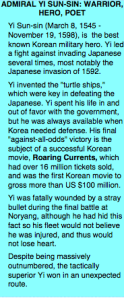Korea’s literary preference has historically been towards poetry and song. In pre-print cultures this is common as the rhythm and rhyme of poetry make it easier to memorize. Even when reliable tools for writing were perfected, the survival of written materials could be quite uncertain. Unless writing is inscribed in rock, it is very fragile and the bamboo of which early books were composed was fragile during a time that Korea was often invaded and had its cities looted. Consequently, song and poetry, passed down from memory to memory, was the first form of Korean literature, just as Homer’s Odyssey found its beginnings in oral rendition, despite the fact we know it as a printed document today. So, while reading the following pages, please be aware that when poetry is mentioned, it often-times refers to sung poetry. At the outset (Ancient Age) of course, there was only oral literature that, during the Medieval Ages (from the first to fifth centuries) shifted to the Chinese characters then used as Korean alphabet, and after the seventeenth century Hangeul (to be discussed shortly) made Korean literature a literature purely of Korean alphabet. And, while The Ancient Age of Korean literature was the apogee of Korean oral literature. Unfortunately, for reasons that we will discuss shortly, most of this literature has dissapeared, and we must judge it by the scant evidence about it that still remains.
Chinese dynastic histories including the Bamboo Annals (prior to 296 BC), History of the Later Han Dynasty (Compiled in the 5th century), and History of Wei (Compiled 551 to 554) mention recitation of religious oral literature by the Korean people as well as the performance of origin myths and histories at early state meetings and in early shamanist-type rituals. In fact these Chinese documents describe the Northern tribes as “the people who enjoy singing and dancing,” (Lee 1). Further, and not surprisingly for a culture which has for the bulk of its existence focused on communality, nature and natural relations, poetry and singing were seen as a way to communicate to and build relationships between Heaven and Earth. In this, certainly, the influences of Animism and Shamanism can be seen.
Oral literature, including song, must be considered a form of Korean literature because of the particular ways that Korea literature split. The literature began, of course, orally and in the vernacular, but slowly slid to Chinese. Eventually the literati (yangban) practiced literature solely in Chinese, while the rest of the Korean world (lower classes and women), used the Korean language. As Chinese-characters were introduced, narrative (folk) poetry was replaced by lyric and didactic poetry known as hyangga. These poems were simple, often short, polished, and quite lyrical and/or philosophical. This literature was initially recorded in Chinese characters that reproduced the sound of Korean words (Hyangch’al) creating the first bridge between the two language, but the creative process was still in the Korean language.
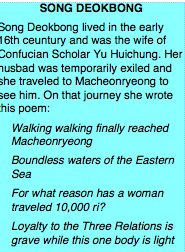 The bulk of the vernacular or common story telling was done in Korean, in verse or song. When hyangch’al disappeared, the schism widened with written literature becoming exclusively composed in Chinese. This left the remainder of literature in the hands of the singers and poets. After hyangga, sijo emerged (don’t worry about these names, we’ll be explaining them soon) and lived alongside kasa. While sijo continued in the lyrical spirit of hyangga, kasa was didactic and entirely composed in Chinese. This split between the lyric and didactic was exacerbated by the introduction of Hangeul, which finally gave the vernacular or common literature an outlet in which to be recorded.
The bulk of the vernacular or common story telling was done in Korean, in verse or song. When hyangch’al disappeared, the schism widened with written literature becoming exclusively composed in Chinese. This left the remainder of literature in the hands of the singers and poets. After hyangga, sijo emerged (don’t worry about these names, we’ll be explaining them soon) and lived alongside kasa. While sijo continued in the lyrical spirit of hyangga, kasa was didactic and entirely composed in Chinese. This split between the lyric and didactic was exacerbated by the introduction of Hangeul, which finally gave the vernacular or common literature an outlet in which to be recorded.
Korean poetry has had a handful of predominant forms and these forms are partially associated with the empires in which they flourished. These forms of poetry help create a broad outline of the development of Classical Korean fiction and provide a broad outline of its history, which will now be examined in closer detail.
Hyangga
Not much remains of Silla Dynastic literature (57 BC to 935 AD). What does remain is the form of hyangga poetry, written in hyangch’al. The word hyangaa means “rural village song” deriving from what the Silla people called their empire. A total of fourteen poems were passed down in the Samguk Yusa: Legends And History Of The Three Kingdoms Of Ancient Korea (c.1285) and eleven more survived in the Tales of Kyunyo. The first of these is recorded in the Samguk Yusa, which also informs us that the poem was sung by members of the Karak State during the third moon in the year 42. This work is the “Seodong-yo” (The Ballad of Seodong), an uncomplicated four-line lyric by a commoner named Seodong, who wrote the poem to persuade the king that the king’s daughter has slept with Seodong. Seodong’s poetic ruse is successful as the princess is banished for her imaginary lack of chastity and eventually marries Seodong.
On more serious note, translator and schoaar Bruce Fulton records:
Hanshi – poetry composed in classical Chinese and following Chinese principles of poetry, but written by Koreans – became widespread among the literati of Unified Shilla (667-935). Stimulating the use of Chinese as a literary language was the rise of Confucianism, illustrated by such developments as the founding of the National Confucian College in 682, and the corresponding necessity of studying the Chinese classics.
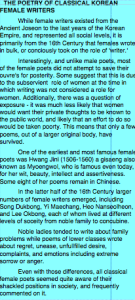 Hanshi, to those with some background in Korean, merely means poetry of the Han – a slightly misleading titled, as the text was all in Chinese. The form of hyangga is varied with some 4-line, 8-line, and 10-line poems. In the 10-line hyanggas the first section introduces the idea of the poem; the second section either distills or distorts feelings related to the topic, and; the third section, only two lines, begins with a declaration and then comes to a strong conclusion. This general form of construction is quite similar to that of the sijo, which we shall discuss shortly. The hyangga Requiem for My Sister, by the Buddhist monk Weolmyeong, demonstrates this structure and until its rather traditional and predictable religious end, is quite beautiful.
Hanshi, to those with some background in Korean, merely means poetry of the Han – a slightly misleading titled, as the text was all in Chinese. The form of hyangga is varied with some 4-line, 8-line, and 10-line poems. In the 10-line hyanggas the first section introduces the idea of the poem; the second section either distills or distorts feelings related to the topic, and; the third section, only two lines, begins with a declaration and then comes to a strong conclusion. This general form of construction is quite similar to that of the sijo, which we shall discuss shortly. The hyangga Requiem for My Sister, by the Buddhist monk Weolmyeong, demonstrates this structure and until its rather traditional and predictable religious end, is quite beautiful.
The road to life and death
Stands fearfully before us.
Without saying good-bye,
Have you left me?
The early morning wind in autumn
Scatters leaves here and there.
Though from the same branch
They know not where they’ve gone.
Oh my dear sister, to see you again in Amitabha’s Paradise,
I shall wait, perfecting Buddha’s way. Trans. Robert Fouser (Kim)
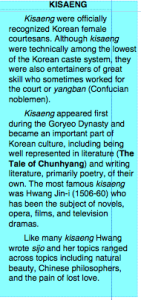 One interesting thing to note is that in comparison to Western poetry these poems
One interesting thing to note is that in comparison to Western poetry these poems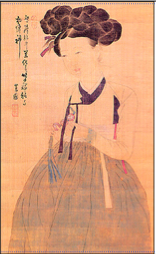 are quite short, and as we shall see this tradition partially continued as Korean literature developed. Thematically, the hyangga are Buddhist and/or warrior-based and they are often euologistic and or extremely didactic.
are quite short, and as we shall see this tradition partially continued as Korean literature developed. Thematically, the hyangga are Buddhist and/or warrior-based and they are often euologistic and or extremely didactic.
During the Goryeo Dynasty (918-1392 AD) the use of hyangch’al disappeared as the use of conventional Chinese characters came to dominate Korean literature. Hyangga did not entirely disappear, but it became a religious form rather than a literary one and the so-called Goryeo Songs appeared. The elimination of hyangch’al meant that there was no even approximate way to write down ‘native’ Korean poetry, so it continued to primarily be expressed orally. During the Goryeo dynasty the elimination of hyangch’al meant that Chinese characters became the de -acto written language of Korean literature. As this occurred, and the Goryeo dynasty become increasingly mannered, it began to look down its nose at poetry composed in hyangch’al, and refused to record and reproduce it. The new form of poetry that developed was the kasa.
The Kasa
Although this form was primarily oral, it lived long enough to be recorded in writing (Hangeul) in the Joseon Dynasty. Unfortunately, for reasons having to do with politics and the language shift, the new dynasty was not particularly interested in saving the literature of the previous dynasty and both through conscious destruction and indifference, much literature was lost. The popularity of Kasa itself continued to grow and it achieved its greatest heights towards the end of the Joseon dynasty
As the Goryeo dynasty declined, this loss of literature overtook much of the Goryeo works as well and when the Joseon Dynasty succeeded the Goryeo, it adopted a stance similar to that the Goryeo had before it: expunge ‘inappropriate’ and ‘obscene’ poetry of the previous dynasty. Thus it is there are barely 60 titles of surviving Goryeo poetry.
In any case, the kasa had two forms, a short (one stanza) form and a longer form (multiple stanzas ranging up to thirteen). Each stanza includes a refrain in the middle or at the end that was intended to establish the mood of the piece or tie the stanzas together. In addition, the kasa was less formally structured, and took on far bolder topics including love, which was often discussed rather bluntly, though kasa was also often bluntly didactic and thus, over time, lost popularity to sijo which tended to the more lyrical. The kasa was often performed by kisaeng, which may give some clue as to why they were more direct and sexual than their predecessors. In general, this form is considered as relatively unimportant during the Goryeo period and is important primarily as it was the basis for the more robust and well known kasas of the Joseon Dynasty. The Manjeoncheun (actually, a shortened version) is an anoymous love poem likely from the mouth of a kisaeng although most readers will likely note a narrator shift towards the end:
Were I to build a bamboo hut on the ice
Were I to die of cold with him on the ice,
O night, run slow, till our love is spent.
When I lie alone, restless, vigilant,
Only peach blossoms wave over the west window.
You have no grief, welcome the spring breeze.
I have believed those who vowed to each other;
“My soul will follow yours forever.”
Who, who persuaded me this was true?
“O duck, beautiful duck, why do you come
To the swamp, instead of the shoal?”
“If the swamp freezes, the shoal will do.
A bed on Mount South, jade pillow, gold brocade.
And beside me a girl sweeter than musk,
Let us press our hearts together, our magic hearts.
(Kim Kichung, 29)
Female writers were generally not published during either the Goryeo or Joseon dynasties, but the record hints that yangban women wrote thousands, probably hundreds of thousands of kasa in Hangul. This was mainly anonymous, and is today known as kyubang kasa, or “inner-room kasa,” so-called because the women’s rooms in a traditional hanok were towards the center of the house. Most of these poems were instructional in nature, advice and admonitions from one generation of woman to another, and typically given to a younger woman on the occasions of her marriage and departure to her husband’s house.
A typical example begins:
Listen, my dear child,
Tomorrow is the day of your leave-taking.
Leaving your parents’ home,
You will be entering your husband’s.
As your heart must be,
So is mine, also uneasy.
Your things loaded on a white horse
And the gilt saddle firmly tied down.
As I send you off out the gate
I have much advice to give you… (Kim, Kichung 125)
Not spellbinding as literature, in fact more intended to be vessels of exemplary advice. But in many cases these kyubang kasa were handed down from generation to generation, and came to include many passages that strayed from direct advice to a bride. In fact, while the the most common form of kasa was admonitory, the kyubang kasa also included the “songs of lament” and the “songs of flower viewing.” The latter, perhaps, hints at the rather philosophical/effete tendencies sometimes evinced by poetry of the era.
Sijo
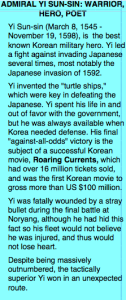 During the Joseon period (1392 – 1897) the focus of Korean poetry shifted to the sijo and kasa. The original sijo poets were yangban who composed sijo to pass time and amuse their friends. There is an amusing split here, because while “serious” literature was supposed to still be composed in Hanja, apparently yangban in Goryeo began to “slum” around in hangeul (Fulton, 27) and this may help explain both the spread of hangeul and the continued popularity of sijo. Consequently themes were often Confucian in nature and focused on loyalty. Sijo had three stanzas (often expressed in lines) of four feet each and can be compared, in some ways to the Japanese haiku, though the longer form of the sijo allows greater explication of themes and more syllab[c flexibility.
During the Joseon period (1392 – 1897) the focus of Korean poetry shifted to the sijo and kasa. The original sijo poets were yangban who composed sijo to pass time and amuse their friends. There is an amusing split here, because while “serious” literature was supposed to still be composed in Hanja, apparently yangban in Goryeo began to “slum” around in hangeul (Fulton, 27) and this may help explain both the spread of hangeul and the continued popularity of sijo. Consequently themes were often Confucian in nature and focused on loyalty. Sijo had three stanzas (often expressed in lines) of four feet each and can be compared, in some ways to the Japanese haiku, though the longer form of the sijo allows greater explication of themes and more syllab[c flexibility.
The form of the sijo is semi-regular – three lines of 14-16 syllables each with total syllables between 44 and 46. When first introduced to sijo readers are often introduced to an ‘idealized” western structure based on syllable count, but this “ideal” is complicated and often inaccurate. A more natural way of exploring the sijo notes that its topic is introduced in the first line, explored in the second line, and then given a surprise twist at the outset of the third line, and then concluded by the end of that line. This structure is intended to create an aesthetically ‘complete’ poem that unfolds in a brief space, but without hurry.
While sijo originated with the yangban expressing philosophical or religious concerns, its popularity quickly spread among common people in the eighteenth century. With this development of popularity among the masses, the form of the sijo also began to change, including an increase in its length, with the new form of sijo being named the p’yong (flat) or changhyong (long form) sijo.
The new sijo also tended to be less rarified, often focusing on commonplace emotions and satire. The first printed compilation of sijo, the Cheonggu Yeongon was not printed until 1728, but many sijo remain scattered in the private collections of the families of the yangban who wrote them.
The sijo below was composed by Admiral Yi Sun-sin in 1599, on the eve of a battle with the Japanese, a battle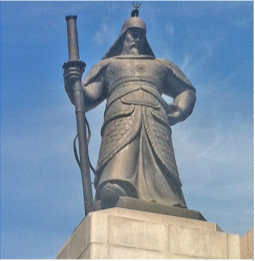 he won, but in which he was unfortunately slain:
he won, but in which he was unfortunately slain:
At Hansan Island Fortress
Moon-bright night on Hansan Isle, and I sit alone atop the lookout.
I hold my great sword by my side, and as my worries deepen.
From somewhere comes the single note of the Mongol flute, piercing to the very bowels.
(McCann, 147)
Readers interested in sijo can find it translated in The Bamboo Grove: An Introduction to Sijo, by Richard Rutt.
Pansori
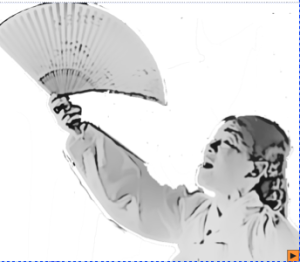 One form of literature of particular note that is still enjoyed today is pansori, or ‘story-in-song.’ Pansori is believed to have developed from the shamanist chants of South-Eastern Korea in the late seventeenth and early eighteenth centuries. Unlike those chants, however, it is not based on religion, in fact often focusing on more tangible targets, sometimes including the yangban and issues of social structure. Pansori began in the second half of the Joseon era (King Succhong or Kim Yeongjo – so 1674-1776) and was most likely, though there is no definitive proof an outgrowth of shaman practicing in Jeolla-do. The huge difference, is that pansori is a kind of subversion of shamanism, in fact often mocking it. (Cho, 66)
One form of literature of particular note that is still enjoyed today is pansori, or ‘story-in-song.’ Pansori is believed to have developed from the shamanist chants of South-Eastern Korea in the late seventeenth and early eighteenth centuries. Unlike those chants, however, it is not based on religion, in fact often focusing on more tangible targets, sometimes including the yangban and issues of social structure. Pansori began in the second half of the Joseon era (King Succhong or Kim Yeongjo – so 1674-1776) and was most likely, though there is no definitive proof an outgrowth of shaman practicing in Jeolla-do. The huge difference, is that pansori is a kind of subversion of shamanism, in fact often mocking it. (Cho, 66)
To western eyes pansori may seem less like literature and more like song and dance, but in Korea pansori is considered a form of literature (of course it is also recognized as song and dance). It is a long (up to eight hours) narrative musical performance with two performers, a drummer and a singer. Pansori consists of two internal musical forms, the main song called ch’ang and rhythmic spoken passages called aniri, with the aniri serving as kind of thread connecting the ch’ang.
Pansori’s emergence was from a primarily oral tradition, and one that revolved around superhuman characters, myths, etc, but by the late Joseon period, pansori had evolved into stories based on more typical events using human characters, and the plots, therefore, became increasingly “true to life.” Pansori mixed prose and verse as well as mixing the vernacular, including slang, sarcasm and jokes, with the more traditional classical language of the past. In fact, in terms of literary “quality” pansori was a kind of pastiche, including well known truisms, vernacularity, a surprising amount of earthy humor, and a mixture of high-level and low-level language (Korean language has formal registers for communication between equals and those who are not equal, for various reasons including age, education, and sex). As time went by, this latter set of opposites caused pansori, initially the literature of the common man, to split into two schools, the common one representing entertainment for the masses and a pansori that continued to depict the lives of the royal court. The latter included the Record of Leisurely Feelings/Records Amidst Leisure (Hanjungnok) and Tale of Queen Inhyon (Inhyon Wanghujon).
Although pansori began in oral tradition, they were passed along from generation to generation and increasingly memorialized in print. There were two different stylistic trands of pansori, the sung (indicated by the Korean word “ka”) and the written (indicated by the Korean word “cheon”). According to Kim Hyunggu the three most popular pansori novels were Tales of Shim Cheong, The Tale of Chunghyang, and the Tale of Heungbu, the latter of which is still popular as a children’s tale. As the popularity of these and similar works grew, and as they were transmitted both orally and in written form, but increasingly in written form from the eighteenth century forward, novels that appealed to common tastes were increasingly prevalent, partly due to the fact that they were also now available in Hangeul. Over time, pansori moved away from relentless focus on one main character and so-called “family novels” become more popular. In general, this period represented the first mercantilization of Korean literature and it is here we can first see the focus of the works moving away from self-expression and meditations of the yangban to a focus on success in the emerging general market for fiction. The length, range of subject, and general appreciation of pansori lead to pansori becoming, in a way, the first ‘common’ literature of Korea as pansori began to be spread in printed form, becoming one of the first forms of the Korean “classic” novel. Pansori peaked in the nineteenth century and began a slow, apparenly inevitable decline. Performances of it can still be found in Korea, but primarily in extremely truncated forms, and only in locations of formal cultural presentation (e.g. the National Theater at Mt. Namsan).
The Mask Dance (and Monkey Play)
Here, purposefully, we elide a form of Korean drama that existed on the borderline between poetry, oral literature, dance and and drama, the so-called “Mask Dance” (talchum) The Mask Dance occupies an odd place in Korean literature – actually a kind of drama in a country in which drama, in the western sense, did not exist until quite recently One might usefully think of the Mask Dance as a form of village-wide psychotherapy in which various social issues were, behind the protection of masks, presented, parodied, the privileged classess pricked and prodded, and strong elements of the shamanic gut included. These dances often ended up with the entire village joining together in a cathartic finale intended to bring release to all involved (Fulton), . Certainly an interesting form of enterntainment, but not a direct step on the path to the “modern” literature towards which this book is headed. Instead, the next ‘literary’ step is the ‘classic” novel.
However, before we discuss the creation of the “classic” novel, and the invention of literature as we know it in the west, we must take a short detour to discuss perhaps the most important development in the creation of a common Korean literature, and that event is the unprecedented creation of a national alphabet, that alphabet being Hangeul.
